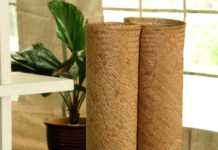Tali kato is the act of weaving traditional baskets in Fiji. The island of Fulaga in Lau, the most southern group of islands of Fiji, is a renowned place for finely woven kato. This craft has been passed down through generations of women and is still actively practiced on the mainland of Viti Levu by Fulaga descendants.
A variety of pandanus leaves are used for talitali (weaving). The processing of the leaves determine the natural shades of tan, with some leaves dyed black and dark brown with mangrove earth pigment to achieve a dramatic patterning against the pale natural pandanus.
The intricacy of patterning applied during tali kato and its seamless form requires a high level of skill and precision in measurements for the fine design application that Fulaga is well known for. Fijian woven baskets shared common characteristics. Black and dark brown fibres are integrated into the weave. Characteristic motifs include the pinwheel and a variety of star shapes set into the central design.
There are many different types of woven baskets that are specific to different uses and are still used for day-to-day activities such as fishing, collecting crops and serving food. Kato (basket) for personal uses display more elaborate and fine weaving techniques today.
There are less than 100 weavers in Fiji. With Fiji being a popular tourist destination this craft has diversified to service Western lifestyles. Tali kato can also be seen in the form of jewellery boxes and gadget cases.
Anaseini Latu Waigaga is a descendant from Fulaga, Lau. She began weaving with coconut leaves, as did most young Fijian girls. Under the guidance of her grandmother, Anaseini learned mat weaving at a very early age, and through her own experiments progressed to basketry. Her work Biscuit Basket was selected for exhibit during the 1972 Pacific Arts Festival and she secured on-going commissions thereafter. Woven works by Anaseini are available from Namana Fiji Arts, Sigatoka, Fiji Islands.





